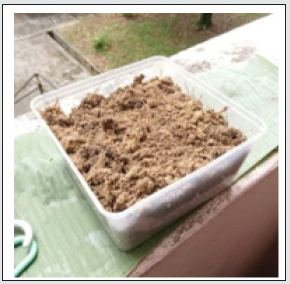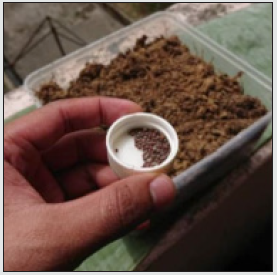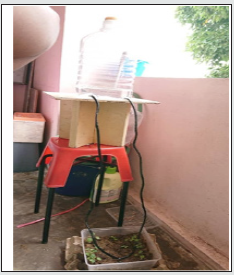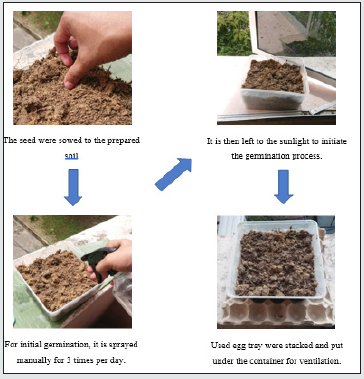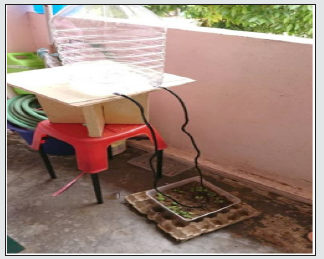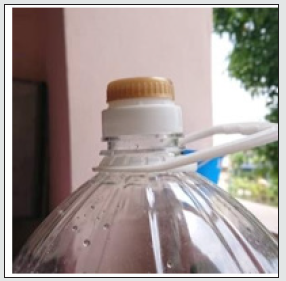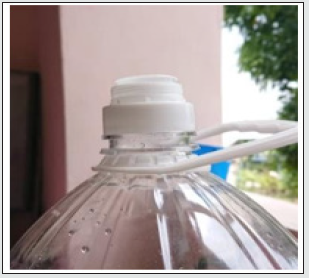
Lupine Publishers Group
Lupine Publishers
Menu
ISSN: 2637-4676
Opinion(ISSN: 2637-4676) 
Performance Evaluation of Mini Fertigation with Rainfall: Effect on Black Mustard Seed Brassica Juncea for Home Agriculture Volume 9 - Issue 3
Mohd Hudzairi Bin Haji Razali* and Muhammad ‘Atif Rizqy Bin Janudin
- Water and Irrigation Management, AGR611, Faculty of Plantation and Agrotechnology, UiTM (Malacca) Jasin Campus, 77300 Merlimau, Melaka, Malaysia
Received: April 01, 2021; Published: April 15, 2021
Corresponding author: Mohd Hudzairi Bin Haji Razali, Water and Irrigation Management, AGR611, Faculty of Plantation and Agrotechnology, UiTM (Malacca) Jasin Campus, 77300 Merlimau, Melaka, Malaysia
DOI: 10.32474/CIACR.2021.09.000314
Abstract
Water and land have been scarce nowadays and the needs for much efficient use of this resources is much important than before especially with the growing population and climate change. The condition is worsened with the global issue which is Covid-19 that has decapitated many of economic activities. Due to this, government has been enforcing strict regulations. The planting of crops especially short-term crop at home is much more relevant than before as there are nothing much that can be done. Combine that with the unutilized source of rainwater, thus come the concept home farming. Brassica Juncea are chosen due to the short life cycle thus would make it easier to cultivate. It is irrigated with water from rain via homemade reservoir thus ensuring no cost at the water side. The needs for much more efficient irrigation method such as utilization of rainwater to create energy can be feasible as there are downward movement of water from the topside of house downwards.
Keywords: Faba bean; Demonstration; Varieties
Introduction
The black mustard seed Brassica Juncea is famous for its use in
food crops. It is often used in the form of vegetables, oilseeds, feed,
green manure, and condiments. It originates in India much before
the Christian era and it is used for many purposes such as oil for
cooking and frying, spice for seasoning foods, vegetables and for
religious ceremonies (Mehra [1]). Since then, the Brassica crop has
been a part of human agriculture system and occupies a predominant
place in the world’s agrarian economy. Originated from Asia,
India, China and Japan is the first of the countries that is known to
start cultivating this type of crop. Prakash[2]; Weiss, [3] has documented
the crop in India, and Yan, 1990 has found the recorded
Chinese word of rapeseed. The earliest use of this crop is as oil for
burning lamps, and poor people use it as an edible oil. At a later centuries,
this crop has become an important use for cooking and lighting
oil. The benefits can be seen in medicines as the Greek, Roman
and Chinese have described its values in their writings at 500-200
BC (Robbelen et al., [4]). The uses of this mustard crop are wide and
not only limited to vegetables. The harvested mustard crop is dried
and can be made into a commercial mustard seed. From there it can
be further processed into fixed oil, bran, prepared mustard paste
and ground mustard. Mostly is with the process of milling, grinding,
and deheating (Cui & Eskin, [5]).
More and more natural habitat is being converted to agricultural
land and this leads to the extensive use of chemicals. This then
leads to the dramatic declination of animals (Carson, [6]). Many
studies have been conducted to prove that agricultural pesticides
can be directly toxic to wildlife species and reduce their food supply.
As the link between the population declines and the utilization
of land for agriculture, it is well-documented by (Rauschenberger
et al., [7]) Water is a renewable resources, but its availability is variable
and limited. Their availability depends on rainfall, temperature,
evaporation, and runoff. With increasing population, current
climate issue, and efficient use of water, it has led to an extensive
problem with the water supply. As of agriculture alone, it accounts
for 87% of the freshwater consumption. That is why, new methods
for efficient use of water especially for agriculture, needs to be done
so that it can be better utilize in other sector, thus would help in
water shortage problems [8].
That leads to the idea of crop cultivation without lands and using
rain as water supply for the crop. That is a much better utilization
of water without using the supplied water to our home. There
are many projects that has been done based on this principle such
as vertical farming, however it still utilizes pipe water. This study
attempts to utilize rain as water supply without the needs of using pipe water, integrated with vertical farming. The best thing about
this system is that there is no electrical system that is utilized, but
rather is purely by using naturally acting forces in our surroundings
such as gravity and atmospheric pressure. The objective of this
study is to design and evaluate the performance of the irrigation
system in term of the plants physical growth and the environment.
Materials and Methods
Planting Material
Preparation
Working Mechanism
Results and Discussions
Physical Analysis
Criteria that is evaluated in the physical analysis includes height of the plant and number of leaves.
Based on Table 1, it can be clearly seen that there is an increment of leaves number from the first measurement is taken to the second measurement. The numbers are constant from day 6 until day 12 as there are an enlargement of the leaf size rather than addition of new leaves. For Table 2, there are a gradual increase in the average plant height of the crop. It increases steadily from day 3 until day 12. The most increment of height can be seed from day 3 to day 6 whereby there are a difference of 1.86 cm. This is due to the rapid growth of the stem of the crop.
Environment Analysis
The environment plays a vital role in the growth of a crop. Without ideal environment, crop will struggle to live and perform to its full potential. That is why the environment needs to be analyzed to know how the plant will react to a set of environmental condition. Apps that is downloaded from Play Store is used to measure the environment factor in this experiment.
Conclusion
To conclude, it can be said that the implementation of this project is a successful one as there are no cost that is incurred due to the materials that is used are all around the house. Surely there are a certain aspects that needs to be improved, but for a start, this is quite good. The flaws can be overcome with some effort it can be much better with a small gradual modifications. Overall, there are no need to go out and buy the materials as it is readily at home, thus conforming to the government recommendation to Stay at Home.
Acknowledgement
I would like to express my gratitude to Assoc. Prod. Dr. Mohd Hudzairi Bin Haji Razali as our Irrigation Lecturer that urges in making our own irrigation system and assures us to send it to Jabatan Pertanian. It may seem like a hard task, but once we get going, it is much easier than it seems.
References
- Mehra KL (1968) History and ethnobotany of mustard in India. Advancing Frontiers of Plant Sciences, 19: 51-59.
- Prakash S (1980) Cruciferous oilseeds in India. Cruciferous Oilseeds in India 151-163.
- Weiss EA (1983) Rapeseed. Oilseed Crops. Longman Group, New York, USA 161-215.
- Robbelen G, Downey RK, Ashri A (1989) Brassica species. Oil Crops of the World: Their Breeding and Utilization. Robelen G, Downey RX, and Ashri A (Eds.). New York: McGraw-Hill, 553.
- Cui W, Eskin, NAM (1998) Processing and properties of mustard products and components. Functional Foods: Biochemical and Processing Aspects. Technomic Publishing Company, Inc., Lancaster, UK, 235-264.
- Carson R (2002) Silent spring. Houghton Mifflin Harcourt.
- Rauschenberger RH, Wiebe JJ, Sepúlveda MS, Scarborough JE, Gross TS (2007) Parental exposure to pesticides and poor clutch viability in American alligators. Environmental Science & Technology, 41(15): 5559-5563.
- Yan Z (1990) Overview of rapeseed production and research in China. Proceedings of the International Canola Conference Potash and Phosphate Institute, Atlanta, Georgia 29–35.

Top Editors
-

Mark E Smith
Bio chemistry
University of Texas Medical Branch, USA -

Lawrence A Presley
Department of Criminal Justice
Liberty University, USA -

Thomas W Miller
Department of Psychiatry
University of Kentucky, USA -

Gjumrakch Aliev
Department of Medicine
Gally International Biomedical Research & Consulting LLC, USA -

Christopher Bryant
Department of Urbanisation and Agricultural
Montreal university, USA -

Robert William Frare
Oral & Maxillofacial Pathology
New York University, USA -

Rudolph Modesto Navari
Gastroenterology and Hepatology
University of Alabama, UK -

Andrew Hague
Department of Medicine
Universities of Bradford, UK -

George Gregory Buttigieg
Maltese College of Obstetrics and Gynaecology, Europe -

Chen-Hsiung Yeh
Oncology
Circulogene Theranostics, England -
.png)
Emilio Bucio-Carrillo
Radiation Chemistry
National University of Mexico, USA -
.jpg)
Casey J Grenier
Analytical Chemistry
Wentworth Institute of Technology, USA -
Hany Atalah
Minimally Invasive Surgery
Mercer University school of Medicine, USA -

Abu-Hussein Muhamad
Pediatric Dentistry
University of Athens , Greece

The annual scholar awards from Lupine Publishers honor a selected number Read More...




